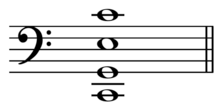Open chord
.png)

In music for stringed instruments, especially guitar, an open chord (open-position chord) is a chord that includes one or more strings that are not fingered. An open string vibrates with more resonance than a string which is pressed down (also known as "fingered" or "fretted"). Thus in an open chord the strings ring, or sound, freer and fuller. On a regular six-string guitar, an open chord can have from one to six open strings sounding. In contrast, all of the strings are fingered for a barre chord. Guitarists use capos, which are devices that clamp down the strings to create a movable nut, to play open chords in different keys. With a capo on the first fret, an open A minor chord would sound like a B♭ minor chord. Open chords on guitar are used in a wide range of popular music and traditional music styles.
Guitar
In guitar music, open chords are also called cowboy chords owing to their simplicity and reminiscence of a "cowboy strummin' away on the prairie."[1]
Other strings
When composers instruct string section players (violin, viola, cello, double bass) to play double stops (two notes at once) or triple stops (three notes at once), they often include one or two open strings in the chord voicing, unless they are writing for a virtuoso soloist. When writing for amateur or youth ensembles, composers typically use open strings to form double stops; in this fashion, the player only has to "stop" one note. Using open strings in double stops and triple stops also improves the resonance and sustain of the chord, because open strings ring more fully and longer than "stopped" strings.